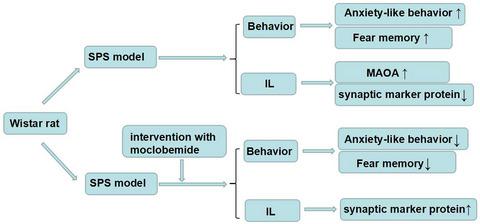Our official English website, www.x-mol.net, welcomes your feedback! (Note: you will need to create a separate account there.)
Administration of moclobemide facilitates fear extinction and attenuates anxiety‐like behaviors by regulating synaptic‐associated proteins in a rat model of post‐traumatic stress disorder
SYNAPSE ( IF 2.3 ) Pub Date : 2020-02-17 , DOI: 10.1002/syn.22146 Bing Xiao 1 , Fang Han 1 , Yuxiu Shi 1
SYNAPSE ( IF 2.3 ) Pub Date : 2020-02-17 , DOI: 10.1002/syn.22146 Bing Xiao 1 , Fang Han 1 , Yuxiu Shi 1
Affiliation

|
Post‐traumatic stress disorder (PTSD) is a long‐lasting mental disorder and accompanied by worse fear extinction. Enhanced fear memory or poor fear extinction are typical features of PTSD. Dysfunction of the serotonergic neurotransmitter system is involved in numerous mental and behavioral disorders. Monoamine oxidase A (MAOA) is important in the metabolism of serotonin and play an important role in behavious. The aim of this study was to explore the change of MAOA and effect of MAOA on fear memory in PTSD. We used single prolonged stress (SPS) to create animal model of PTSD. A startle/fear box and elevated plus maze were used to observe fear memory and anxiety level, respectively. We examined the expression of MAOA and synaptic marker protein, as well as the immunological activity of MAOA in the infralimbic cortex (IL) area, which is a critical brain region involved in emotions, especially fear regulation. We found increased anxiety‐like behavior, dysfunction in fear extinction, and increased MAOA in SPS rats. After treatment with moclobemide (a selective inhibitor of MAOA), SPS rats showed significantly improved fear memory and decreased anxiety‐like behavior, which indicated that moclobemide could reverse fear extinction deficit and attenuate abnormally increased levels of anxiety caused by SPS in short term. On the contrary, decreased PSD‐95 and SYN1 expression in the IL region were also reversed by moclobemide. These results suggest that increased MAOA play a negative role in fear extinction and levels of anxiety in PTSD, which may be involved in change in PSD‐95 and SYN1.
中文翻译:

在创伤后应激障碍大鼠模型中,吗氯贝胺通过调节突触相关蛋白促进恐惧消退并减轻焦虑样行为
创伤后应激障碍(PTSD)是一种长期的精神障碍,伴随着更严重的恐惧消退。增强的恐惧记忆或较差的恐惧消退是 PTSD 的典型特征。5-羟色胺能神经递质系统的功能障碍与许多精神和行为障碍有关。单胺氧化酶 A (MAOA) 在血清素的代谢中很重要,在行为中起重要作用。本研究的目的是探讨 MAOA 的变化以及 MAOA 对 PTSD 恐惧记忆的影响。我们使用单一长期压力 (SPS) 来创建 PTSD 的动物模型。分别使用惊吓/恐惧盒和高架十字迷宫来观察恐惧记忆和焦虑水平。我们检查了 MAOA 和突触标记蛋白的表达,以及 MAOA 在边缘下皮层 (IL) 区域的免疫活性,这是一个重要的大脑区域,涉及情绪,尤其是恐惧调节。我们发现 SPS 大鼠的焦虑样行为增加、恐惧消退功能障碍和 MAOA 增加。吗氯贝胺(MAOA的选择性抑制剂)治疗后,SPS大鼠的恐惧记忆显着改善,焦虑样行为减少,这表明吗氯贝胺可以在短期内逆转恐惧消退缺陷并减轻SPS引起的异常增加的焦虑水平。相反,吗氯贝胺也可以逆转 IL 区域 PSD-95 和 SYN1 表达的降低。这些结果表明,增加的 MAOA 在 PTSD 的恐惧消退和焦虑水平中起负面作用,这可能与 PSD-95 和 SYN1 的变化有关。我们发现 SPS 大鼠的焦虑样行为增加、恐惧消退功能障碍和 MAOA 增加。吗氯贝胺(MAOA的选择性抑制剂)治疗后,SPS大鼠的恐惧记忆显着改善,焦虑样行为减少,这表明吗氯贝胺可以在短期内逆转恐惧消退缺陷并减轻SPS引起的异常增加的焦虑水平。相反,吗氯贝胺也可以逆转 IL 区域 PSD-95 和 SYN1 表达的降低。这些结果表明,增加的 MAOA 在 PTSD 的恐惧消退和焦虑水平中起负面作用,这可能与 PSD-95 和 SYN1 的变化有关。我们发现 SPS 大鼠的焦虑样行为增加、恐惧消退功能障碍和 MAOA 增加。用吗氯贝胺(MAOA的选择性抑制剂)治疗后,SPS大鼠的恐惧记忆明显改善,焦虑样行为减少,这表明吗氯贝胺可以在短期内逆转恐惧消退缺陷并减轻SPS引起的异常增加的焦虑水平。相反,吗氯贝胺也可以逆转 IL 区域 PSD-95 和 SYN1 表达的降低。这些结果表明,增加的 MAOA 在 PTSD 的恐惧消退和焦虑水平中起负面作用,这可能与 PSD-95 和 SYN1 的变化有关。SPS大鼠的恐惧记忆显着改善,焦虑样行为减少,表明吗氯贝胺可以逆转恐惧消退缺陷,并在短期内减轻SPS引起的异常增加的焦虑水平。相反,吗氯贝胺也可以逆转 IL 区域 PSD-95 和 SYN1 表达的降低。这些结果表明,增加的 MAOA 在 PTSD 的恐惧消退和焦虑水平中起负面作用,这可能与 PSD-95 和 SYN1 的变化有关。SPS大鼠的恐惧记忆显着改善,焦虑样行为减少,表明吗氯贝胺可以逆转恐惧消退缺陷,并在短期内减轻SPS引起的异常增加的焦虑水平。相反,吗氯贝胺也可以逆转 IL 区域 PSD-95 和 SYN1 表达的降低。这些结果表明,增加的 MAOA 在 PTSD 的恐惧消退和焦虑水平中起负面作用,这可能与 PSD-95 和 SYN1 的变化有关。
更新日期:2020-02-17
中文翻译:

在创伤后应激障碍大鼠模型中,吗氯贝胺通过调节突触相关蛋白促进恐惧消退并减轻焦虑样行为
创伤后应激障碍(PTSD)是一种长期的精神障碍,伴随着更严重的恐惧消退。增强的恐惧记忆或较差的恐惧消退是 PTSD 的典型特征。5-羟色胺能神经递质系统的功能障碍与许多精神和行为障碍有关。单胺氧化酶 A (MAOA) 在血清素的代谢中很重要,在行为中起重要作用。本研究的目的是探讨 MAOA 的变化以及 MAOA 对 PTSD 恐惧记忆的影响。我们使用单一长期压力 (SPS) 来创建 PTSD 的动物模型。分别使用惊吓/恐惧盒和高架十字迷宫来观察恐惧记忆和焦虑水平。我们检查了 MAOA 和突触标记蛋白的表达,以及 MAOA 在边缘下皮层 (IL) 区域的免疫活性,这是一个重要的大脑区域,涉及情绪,尤其是恐惧调节。我们发现 SPS 大鼠的焦虑样行为增加、恐惧消退功能障碍和 MAOA 增加。吗氯贝胺(MAOA的选择性抑制剂)治疗后,SPS大鼠的恐惧记忆显着改善,焦虑样行为减少,这表明吗氯贝胺可以在短期内逆转恐惧消退缺陷并减轻SPS引起的异常增加的焦虑水平。相反,吗氯贝胺也可以逆转 IL 区域 PSD-95 和 SYN1 表达的降低。这些结果表明,增加的 MAOA 在 PTSD 的恐惧消退和焦虑水平中起负面作用,这可能与 PSD-95 和 SYN1 的变化有关。我们发现 SPS 大鼠的焦虑样行为增加、恐惧消退功能障碍和 MAOA 增加。吗氯贝胺(MAOA的选择性抑制剂)治疗后,SPS大鼠的恐惧记忆显着改善,焦虑样行为减少,这表明吗氯贝胺可以在短期内逆转恐惧消退缺陷并减轻SPS引起的异常增加的焦虑水平。相反,吗氯贝胺也可以逆转 IL 区域 PSD-95 和 SYN1 表达的降低。这些结果表明,增加的 MAOA 在 PTSD 的恐惧消退和焦虑水平中起负面作用,这可能与 PSD-95 和 SYN1 的变化有关。我们发现 SPS 大鼠的焦虑样行为增加、恐惧消退功能障碍和 MAOA 增加。用吗氯贝胺(MAOA的选择性抑制剂)治疗后,SPS大鼠的恐惧记忆明显改善,焦虑样行为减少,这表明吗氯贝胺可以在短期内逆转恐惧消退缺陷并减轻SPS引起的异常增加的焦虑水平。相反,吗氯贝胺也可以逆转 IL 区域 PSD-95 和 SYN1 表达的降低。这些结果表明,增加的 MAOA 在 PTSD 的恐惧消退和焦虑水平中起负面作用,这可能与 PSD-95 和 SYN1 的变化有关。SPS大鼠的恐惧记忆显着改善,焦虑样行为减少,表明吗氯贝胺可以逆转恐惧消退缺陷,并在短期内减轻SPS引起的异常增加的焦虑水平。相反,吗氯贝胺也可以逆转 IL 区域 PSD-95 和 SYN1 表达的降低。这些结果表明,增加的 MAOA 在 PTSD 的恐惧消退和焦虑水平中起负面作用,这可能与 PSD-95 和 SYN1 的变化有关。SPS大鼠的恐惧记忆显着改善,焦虑样行为减少,表明吗氯贝胺可以逆转恐惧消退缺陷,并在短期内减轻SPS引起的异常增加的焦虑水平。相反,吗氯贝胺也可以逆转 IL 区域 PSD-95 和 SYN1 表达的降低。这些结果表明,增加的 MAOA 在 PTSD 的恐惧消退和焦虑水平中起负面作用,这可能与 PSD-95 和 SYN1 的变化有关。



























 京公网安备 11010802027423号
京公网安备 11010802027423号